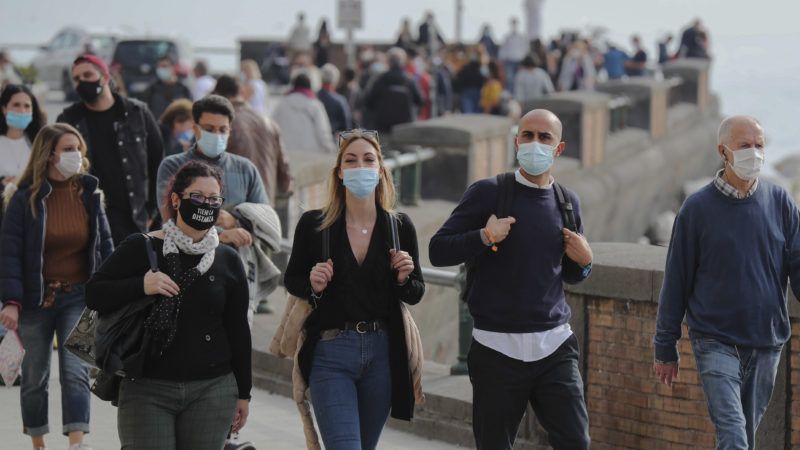Masks Not Very Effective at Protecting Wearers, Says New Danish Study
But masks are still likely to prevent infected people from transmitting the virus.

The urgency of trying to control the COVID-19 pandemic has spurred public health researchers to search for evidence-based measures that might work to protect the public from becoming infected. Non-pharmaceutical interventions have ranged from hard lockdowns to recommendations on social distancing and consistent hand hygiene. Along with those interventions, researchers have sought to evaluate the usefulness of wearing face masks as a way to possibly slow the transmission of the COVID-19 virus.
New research published in the Annals of Internal Medicine finds that masks don't appear to protect the people wearing them, but are still likely to prevent sick people who wear them from spreading their illness.
This research may receive a hostile reception from some quarters, but it's important to learn everything we can about when and how masks work. Masks may mitigate the pandemic by preventing the spread of the COVID-19 virus from infected people to others (source control), by protecting wearers (protective effect), or both. Among other evidence considered by researchers and public health officials are the equivocal results of older face mask studies done well before the current public health emergency (and far less urgently), along with observational studies that try to tease out their efficacy or lack thereof on the fly.
Randomized controlled trials (RCT), in which one group of participants is randomly assigned the treatment while the control group receives standard care, are the gold standard for determining the efficacy of medical treatments. For example, recent COVID-19 vaccine RCTs report that those inoculations are 95 percent effective in preventing viral infections. However, earlier facial covering RCTs have been generally too small to securely rule in or rule out treatment effects. In many studies, adherence to the study protocols was somewhat inconsistent.
Earlier this year, as the pandemic was taking hold, a team of Danish researchers launched an RCT to assess whether recommending the use of a surgical mask outside the home reduces wearers' risk for COVID-19 infection. In the study, a total of 3,030 participants were randomly assigned to the recommendation to wear masks, and 2,994 were assigned to the control group. Both groups were urged to maintain recommended social distancing and hygiene practices. The participants were tested after a month to see if they had developed antibodies to the virus. The study was designed to find out if wearing masks would reduce the coronavirus infection rate among wearers compared to non-wearers by more than 50 percent in a community setting with modest infection rates.
In their article, published by the journal Annals of Internal Medicine, the researchers report that: "In this community-based, randomized controlled trial conducted in a setting where mask-wearing was uncommon and was not among other recommended public health measures related to COVID-19, a recommendation to wear a surgical mask when outside the home among others did not reduce, at conventional levels of statistical significance, incident [COVID-19] infection compared with no mask recommendation."
In other words, in this study, wearing a mask did not significantly reduce a person's risk of COVID-19 infection compared to the risks facing those who did not wear masks. The authors noted that their "findings are inconclusive, with CIs [confidence intervals] compatible with a 46% decrease to a 23% increase in infection." A confidence interval is a range of values in which the researchers are fairly sure the true value lies. As an accompanying editorial in the journal explained, "The evidence excludes a large personal protective effect, weakly supports lesser degrees of protection, and cannot statistically exclude no effect."
Despite finding that masks don't do much to personally protect wearers from becoming infected, the researchers cautioned that their findings "should not be used to conclude that a recommendation for everyone to wear masks in the community would not be effective in reducing [COVID-19] infections, because the trial did not test the role of masks in source control of [COVID-19] infection." The accompanying editorial in the journal emphasized that "the trial does not address the [question] about transmission in communities where most people wear masks and does not disprove the effectiveness of widespread mask-wearing."
The Danish researchers apparently experienced difficulty in finding a journal to publish their results. Their study had reportedly been rejected by The Lancet, the New England Journal of Medicine, and the Journal of the American Medical Association. Although I have no insight on the motivations of the editors of those journals, it is never OK to suppress research findings on the grounds that they might be twisted and abused by unscrupulous ideologues.
The accompanying Annals of Internal Medicine editorial pushed back against the suggestion that, given the politicization of mask-wearing as a public health measure, the journal was being "irresponsible" by publishing results that "could easily be misused by those opposed to mask recommendations." The editorial properly countered that it would be more irresponsible "to not publish the results of carefully designed research because the findings were not as favorable or definitive as some may have hoped. We need to gather many pieces of evidence to solve the puzzle of how to control the [COVID-19] pandemic."
The editorial concludes that the Danish study's "findings reinforce the importance of social distancing and hygiene measures and suggest that masks likely need to be worn by most if not all people to reduce community infection rates, which in turn will protect individuals." In other words, the preponderance of the evidence still indicates that if most people wear masks in public indoor spaces and when among crowds outdoors, those of us who are pre-symptomatic or asymptomatic will be less likely to infect other people. As free and responsible individuals, we should want to avoid causing harm to other non-consenting people.
Show Comments (262)